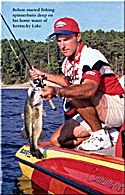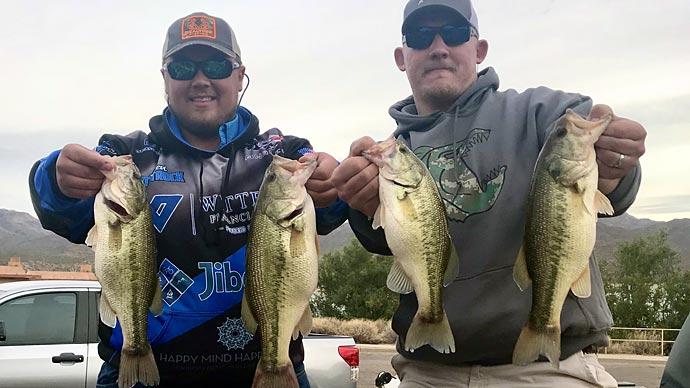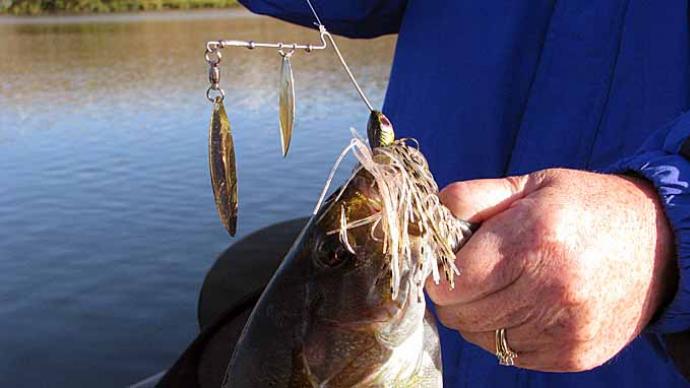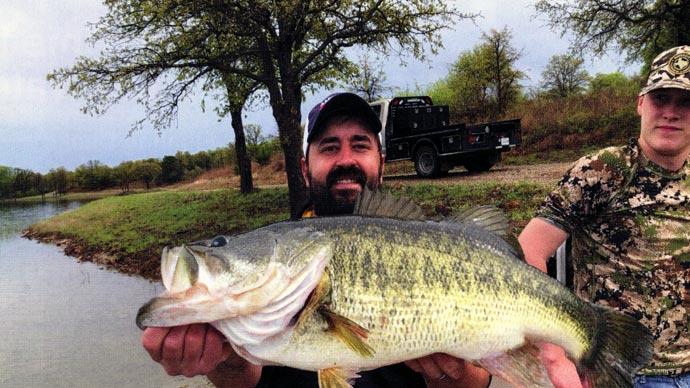| Bolton Talk |
Nix trailer hooks "I never put a trailer hook on a heavy spinnerbait when fishing deep water," Bolton says. "I've adopted a theory that they'll either get it or won't. Since this method attracts mainly big bass, they don't seem to have any trouble engulfing the lure." Sunshine advantage "When the bass are deep," Bolton says, "I do better when there's sun on the water than an overcast day. I'm not talking about a bluebird sky that follows a cold front but a sunny day with some clouds moving through. It may be that the sun helps light up the blades in deep water and makes the bait more visible to bass." Retrieve variations In most instances, Bolton sticks with a slow, steady retrieve when fishing spinnerbaits deep. When this presentation fails, especially when Bolton is confident bass are present, he alternately cranks the lure several feet and then lets it fall to the bottom. |

Every competitive bass angler owns a passel of spinnerbaits and relies on them heavily. The downside to this exceptional lure is that bass see it all too frequently, particularly during major tournaments. This overexposure causes bass to shy away from spinnerbaits, especially bass relating to shallow cover where spinnerbaits are most often fished.
To maintain high spinnerbait productivity under heavy fishing pressure, Terry Bolton of Paducah, Ky., takes spinnerbaits to the extreme and employs them as deep-water structure lures.
Bolton, who has qualified for multiple FLW Championships, began dredging deep water with spinnerbaits nearly a decade ago while fishing tournaments on Kentucky Lake, his home water. He immediately began catching bass with the method and even won several tournaments. Though more anglers are beginning to experiment with deep spinnerbaits, few have mastered the system's nuances more thoroughly than Bolton.
Lures & Tackle
Bolton's primary deep spinnerbaits weigh 5/8, 3/4, and 1 ounce, with the 3/4-ouncer being the workhorse. He is currently helping design 3/4 and 1-ounce counter-rotating spinnerbaits, soon to be introduced by Riverside Lures.
"I can fish a 5/8-ounce spinnerbait down to about 10- to 12-feet," Bolton says. "A 3/4-ounce spinnerbait gets down to the 17- to 18-foot range. It takes a 1-ounce bait to be effective at 20 feet or more."
His favorite blade combinations include double willow leafs with No. 3 and No. 5 blades and a No. 3 Colorado leaf blade followed by a No. 5 willow leaf. He alternates between gold and silver blades and may use silver and gold in combination.
Bolton's bread-and-butter color is chartreuse and white, though he will switch to an all chartreuse, white, or metal flake skirt. His best luck with chartreuse usually occurs during late summer. Whatever the season, he always tips the spinnerbait's hook with a 4-inch white or chartreuse curly tail trailer.
Bolton makes long casts and hard hook sets with a 7-foot, 3-inch, medium-heavy, fast-action baitcasting rod and 15-pound Seaguar InvizX line. Lighter line would allow the spinnerbait to sink faster, but it has too much stretch to ensure solid hook-sets when fishing deep.
Pre-Spawn
"I start out fishing deep spinnerbaits in early spring when the water temperature is around 55 degrees," Bolton says. "I concentrate on steep main lake banks, points at the mouths of bays, and the first points inside side bays."
In stained water, Bolton may find the bass holding on points only 6 feet deep. The bass may hold roughly 10 feet deep in lightly stained to clear water. High, muddy water renders this pattern useless.
When fishing a point at the mouth of a bay, Bolton positions his boat on the main lake side of the point in 15- to 20 feet of water and casts up on top of the structure. By making repeated casts, he works his way around the end of the point and into the mouth of the bay.
The pre-spawn phase is the only time Bolton opts for round blades with stronger vibrations, which draw more strikes in stained water. One of his more productive blade combinations combines a No. 2 Colorado and a No. 5 Indiana.
"I cast up into 3- to 5-feet of water and let the bait sink straight down to the bottom," Bolton says. "Then I give my rod a gentle sideways pull to get the spinnerbait upright and start the blades rotating. I try to maintain a slow retrieve that keeps the lure floating within a foot of the bottom."
If the point drops off sharply, Bolton briefly hesitates his retrieve now and then to keep the spinnerbait close to the bottom. Occasionally, he feels the bait bump into a rock, stump, or brush. Strikes are often soft and mushy at this time of year. Bass run big, however, which is true whenever this technique is successful.
Post-Spawn
Once bass move up into spawning areas, Bolton puts away his deep spinnerbait rod until the water warms to about 75 degrees. By then, many bass have completed spawning and begun migrating toward the main lake.

"That's when I target their first stopping-off points," Bolton says. "These could be any points or bars connected to the bank, such as a point at the mouth of a small cove." The basic spinnerbait presentation remains the same, except that post-spawn bass hold deeper than at any other time of year.
"I catch a lot of bass 15- to 18-feet deep at this time," Bolton says. "Sometimes, I'll get into them deeper than 20 feet. I back my boat out to about 25 feet of water and cast the spinnerbait up into the 8- to 10-foot depth range."
Points embellished with stumps and other cover generally hold more bass, but Bolton believes shad are the main attraction for post-spawn fish. He idles over likely structures while intently studying his depth finder for clusters of shad within 5 feet of the bottom. Wherever he locates shad, he feels confident bass are nearby.
"I keep a marker buoy on the deck," Bolton says, "because I often find post-spawn bass in bunches. When I hook a bass, I kick the marker overboard to return to where I got the strike. On several occasions, a buoy has helped me catch five bass on consecutive casts that weighed well over 20 pounds."
Bolton has enjoyed this kind of furious action while casting deep spinnerbaits to post-spawn bass on Kentucky Lake, Kerr Reservoir, Sam Rayburn, and elsewhere. On Rayburn, and other lakes that feature submergent weed growth, Bolton slow rolls his spinnerbait so it ticks the top of the vegetation.
Summer
Through July and August, many bass relate to main lake river channel ledges, which often lie far offshore. The fish also make critical changes in their feeding habits, forcing Bolton to adjust his spinnerbait tactics.
"Bass generally move shallower in the summer due to the thermocline and a lack of oxygen in deep water," Bolton says. "I catch most of them on the tops of ledges 5- to 10-feet deep."
Bass also scatter and relate to specific objects, such as individual stumps. As a result, Bolton generally picks off hot weather bass one at a time. When studying a ledge he's never fished, Bolton idles over the structure in 5- to 8 feet of water and drops a marker buoy any place he spots a stump or some other object capable of holding a bass. He then swings back around and fishes the specific cover he has located.
"I position the boat over the river channel but stay close enough to the ledge so I can cast up into 5 feet of water," Bolton says. "When my line tightens as the bait pulls up on something, I reel a little faster. I want the spinnerbait to clip over the stump, limb, or whatever the object is. Many strikes come just as the bait clears the cover. I've caught bass doing this on almost all the Tennessee River impoundments."
The bass on main lake ledges remain inactive on power-generating reservoirs until power generation creates a current. The moving water turns fish on like a switch, and Bolton targets prime ledges at these times to take advantage of the feeding spree.
"Current is the key on main lake ledges," Bolton says. "But it isn't necessary when you're fishing ledges in creeks and bays off the main lake. I believe a population of bass live on main lake ledges in the summertime, and other fish stay in the bays throughout the year. I often start in the morning fishing ledges in bays. Then I change to main lake ledges when power generation kicks in, which is typically 11 or 12 o'clock."
When fishing a ledge or point influenced by the current, Bolton concentrates on the down current end of the structure. He also casts upstream above the structure or object he wants to fish to compensate for the current's thrust against his spinnerbait. In other words, he leads his target and lets the current sweep the spinnerbait into the strike zone.
Fall
Bass move up and feed on shad in the fall; many are taken in the shallows. Bolton still scores well at this time by fishing heavy spinnerbaits on ledges in water no more than 7 feet deep, presenting his spinnerbaits to deeper bass than most other anglers who fish blade baits. Bolton's deep spinnerbait edge helps him stay atop the competition.
Content provided by Bass Fishing Magazine, the official publication of FLW Outdoors




